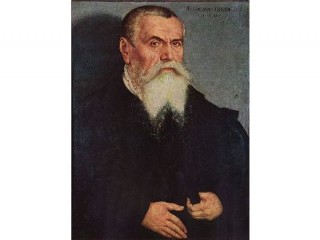
Lucas Cranach The Elder biography
Date of birth : 1472-10-04
Date of death : 1553-10-16
Birthplace : Kronach, Franconia
Nationality : German
Category : Historian personalities
Last modified : 2011-10-18
Credited as : artist painter, engraver, designer of woodcuts
The German painter, engraver, and designer of woodcuts Lucas Cranach the Elder is best known for the delightfully mannered style he practiced as court painter to the electors of Saxony.
Lucas Cranach the Elder was born at Kronach, Franconia. He was apparently trained by his father, Hans, a painter, and from 1495 to 1498 undertook work at Kronach for Coburg and Gotha. There is evidence that Cranach resided in Vienna between about 1500 and 1504. In 1504 he married Barbara Brengbier of Gotha; they had three daughters and two sons, Hans (died 1537) and Lucas the Younger (1515-1586), both of whom were painters.
In 1505 Cranach established residence at Wittenberg, where he was court painter to three successive electors: Frederick the Wise, John the Constant, and John Frederick the Magnanimous. Cranach was a prosperous and respected citizen. He owned several houses and land, held the office of councilor, and was a burgomaster. He also worked for other princely patrons and was a follower and lifelong friend of Martin Luther.
In 1550 Cranach followed John Frederick the Magnanimous to Augsburg, where the elector was in exile, and in 1552 accompanied him to Weimar. Cranach died in Weimar on Oct. 16, 1553.
Cranach's earliest known works belong to the period of his Vienna residence and are strongly expressive in style, with figures and landscape dramatically united in movement; an interest in picturesque landscape manifests itself, anticipating tendencies peculiar to the so called Danube school. Characteristic examples are St. Jerome in Penitence (1502), the half-length portraits of Dr. Johannes Cuspinian and his wife Anna (ca. 1502-1503), and the Crucifixion in Munich (1503). In the composition of the Crucifixion Cranach broke sharply with iconographic tradition and employed ployed bold foreshortening and other spatial devices that reflect a knowledge of the art of Michael Pacher and, through it, of Andrea Mantegna. In Cranach's first signed painting, Rest on the Flight into Egypt (1504), the spirit is idyllic and the actions of the figures are lively.
Cranach's work became less emotional after he moved to Wittenberg in 1505, although the change was slower in the woodcuts than in the paintings. His woodcuts were technically inspired by Albrecht Dürer's but less finely cut and less clearly organized. In Cranach's woodcuts a dramatic emphasis prevailed, and a preference for tone led, by 1509, to the use of the chiaroscuro technique, as in the St. Christopher of 1506, reused or recut and printed with a color block in 1509. The change in style in the paintings may be seen in the Martyrdom of St. Catherinein Dresden (1506), in which the emphatic rendering of the garment patterns, the falling tongues of fire, and the crowding of the figures result in a loss of compositional unity and spatial clarity; and in the Holy Kinship Altarpiece (1509), painted soon after Cranach's trip to the Netherlands, in which Flemish influence accounts for the general disposition and costumes of the figures.
Thereafter Cranach's painting was increasingly distinguished by minimal modeling, stress on linear detail, clean contours, and, in the portraits and most pictures of one or two figures, unmodeled backgrounds. This may be observed in works of such diverse subject matter as the Madonna and Child in Breslau (ca. 1510), the model for many variants to issue from his workshop; Cardinal Albrecht of Brandenburg as St. Jerome in His Study (1525), based on Dürer's engraving St. Jerome in His Study; the Judgment of Paris (1530) and Venus (1532), in which the subjects are classical but the interpretation is pervaded by a naive charm due in large part to Cranach's curvaceous, gently erotic female nudes; the full-length portraits of Duke Henry the Pious and his wife Catherine (1514); the Fountain of Youth (1546); and Reformation pictures like the Fall and Salvation (1529) and Christ Blessing the Little Children (1538). Cranach also painted hunting scenes for the lodges of his princely patrons.
Cranach's drawings include eight pages of marginal illustrations for the Prayer Book of Maximilian (1515) and magnificent animal and portrait studies, like the head of Martin Luther's father (ca. 1527). His best-known engraving is the Penance of St. John Chrysostom (1509).
















